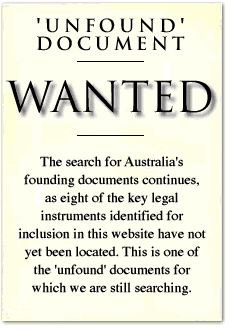

Governor Phillip's Instructions 25 April 1787 (GB)
Significance
These Instructions are the first official communication concerning the occupation and settlement of Australia. They empower Arthur Phillip to establish the first British Colony in Australia and to make grants of land and issue regulations for the Colony. They comprise a type of founding 'constitution' for the new Colony.
History
Six years after James Cook landed at Botany Bay and gave the territory its English name of 'New South Wales', the American colonies declared their independence and war with Britain began. Access to America for the transportation of convicts ceased, and overcrowding in British gaols soon raised official concerns.In 1779, Joseph Banks, the botanist who had travelled with Cook to New South Wales, suggested Australia as an alternative place for transportation. The proposal was repeated later by James Matra, who had also sailed on the Endeavour. The advantages of trade with Asia and the Pacific were also raised, alongside the opportunity New South Wales offered as a new home for the American Loyalists who had supported Britain in the War of Independence. Eventually the Government settled (although not without criticism) on Botany Bay as the site for a colony. Secretary of State, Lord Sydney, chose Captain Arthur Phillip of the Royal Navy to lead the fleet there and to be the first governor.
Prior to his departure for New South Wales, Phillip received his Instructions (composed by Lord Sydney) from King George III, 'with the advice of his Privy Council'. The first Instructions included Phillip's Commission as Captain-General and Governor-in-Chief of New South Wales. An amended Commission, dated 25 April 1787, designated the territory of New South Wales as including 'all the islands adjacent in the Pacific Ocean' and running westward to the 135th meridian, that is, about mid-way through the continent.
The Instructions advised Phillip about managing the convicts, granting and cultivating the land, and exploring the country. The Aborigines' lives and livelihoods were to be protected and friendly relations with them encouraged, but the Instructions make no mention of protecting or even recognising their lands. It was assumed that Australia was terra nullius, that is, land belonging to no one. This assumption shaped land law and occupation for more than 200 years.
Although they were instructed to establish themselves at Botany Bay, Phillip was separately authorised to choose any other appropriate neighbouring territory. The First Fleet set out from Portsmouth on 13 May 1787 and arrived at Botany Bay on 18 January 1788. They quickly found the location unsuitable (fresh water was inadequate and the anchorages were too open in the wide bays); they moved on to the waters of Port Jackson. The First Fleet settled at Sydney Cove on the day that would become 'Australia Day', 26 January 1788. When the last vessel left for England in November 1788, a quantity of clay from Sydney was consigned to Josiah Wedgwood on the suggestion of Sir Joseph Banks, and from this first export the Wedgwood Sydney medallions were made.
Research trail
This important document is not held in any Australian collection. The search for Phillip's Instructions involved re-checking the holdings of State Records New South Wales, the Mitchell Library Manuscript Collection at the State Library of New South Wales, and the National Library of Australia. An additional check was made at the Public Record Office in London, although had the document been held there, it would have been included on the Australian Joint Copying project microfilm.Although the original Instructions have not been located, the search at the Public Record Office in London located a manuscript draft of the Instructions prepared on 20 April 1787 (CO 201/1 ff 29–45v). This draft shows a number of corrections, such as 'Natives' for 'Savages' and interesting amendments, such as the deletion of two pages referring to the implementation, in Phillip's administration, of tenets and practices of the Church of England. The deleted section begins with the statement that it is the Royal Intention that inhabitants 'should have full liberty of Conscience and the free Exercise of all such modes of Religious Worship as are not prohibited by Law'. A single paragraph is substituted for this long deleted section of the Instructions:
And it is furher Our Royal Will & Pleasure that you do by all proper Methods enforce a due Observance of Religion & good order among all the Inhabitants of the new Settlement and that you do take such steps for the due Celebration of publick Woirship as circumstances will permit.The transcript of Governor Phillip's instructions for this website has been prepared from the copy of the Instructions printed in Historical Records of New South Wales, Vol. 2, Part 2.
